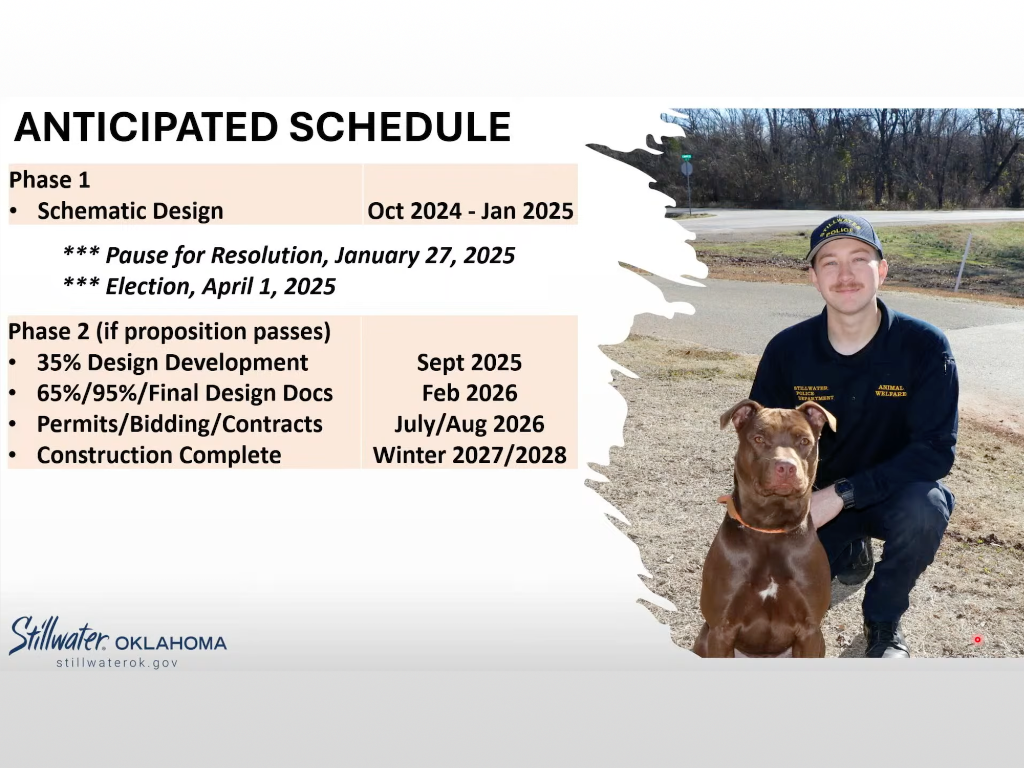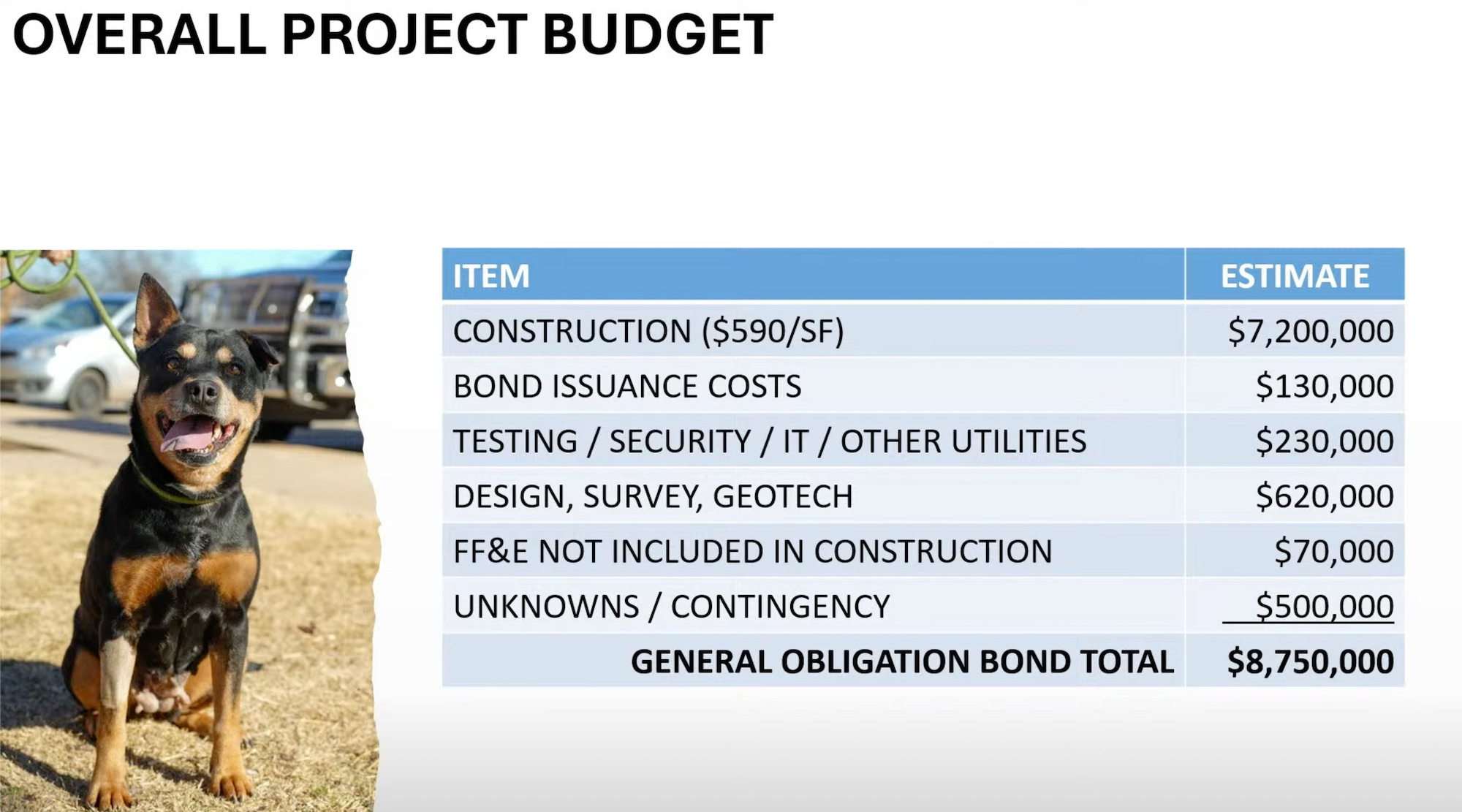
At Monday’s City Council meeting, councilors reviewed presentations on the proposal to build a new animal welfare facility and options for a general obligation bond to finance the project.
City staff estimated it would cost $7.2 million to construct a new 12,200 square foot facility. After incorporating design costs, utility services, furnishings, and a contingency budget of $500,000, the projected total cost is $8.75 million.

Chris Gander, a representative from Bank of Oklahoma Securities, presented an estimate of the tax implications for property owners of a 10-, 15-, or 20-year term bond. Gander explained that the principal amount of the loan is always being paid down, resulting in a continuous reduction in the payments over the lifetime of the debt.
“The median home price [in Stillwater] is around $240,000,” Gander said. “So that it’d be about $5.50 per month on that house at the high water mark … but on average it would be $2.75 if you did it for 15 years.”
- For comparison: In 2022, voters passed a $9 million, 20-year-term GO bond for Fire Station #2 that is set to complete construction this year.
After the presentation, Stillwater Mayor, Will Joyce, asked how councilors felt about the term options. Vice Mayor Amy Dzialowski said she liked the middle, 15-year term. Councilor Christy Hawkins agreed.
“I like the 15-year term,” Hawkins said. “It’s doable and it doesn’t increase the amount people are paying significantly enough that it does seem worth getting it paid off 5 years early.”
Councilors then directed staff to draft a resolution for a 15-year bond for $8.75 million to be presented at the Jan. 27, 2025, meeting where they could vote to adopt the resolution and set a bond election date for April 1, 2025.
Reflecting on rising construction cost issues that delayed the Fire Station #2 project, Councilor Tim Hardin questioned the $500,000 contingency fund amount.
“Do we think that’s enough?” Hardin asked. “I don’t want to run into a situation like we did with the fire station where we really got hit with inflation that really hurt us.”
Director of Engineering, Candy Staring, explained how animal welfare staff worked with consultants to come up with a design that will meet the community's current and future needs while keeping costs to a minimum.
“Staff are very focused on the need here and how critical we are for this animal shelter. We are doing our very best to stay right on the line,” Staring said. “$500,000 is concerning, but we’d rather have the project happen than not happen.”
Starling also mentioned there could be some contingency savings in some of the cost estimate line items.

Barrett Williamson with Barrett L. Williamson Architects gave an overview of the preliminary design and features of the new animal welfare facility and noted staff’s goal to create a solution that voters would approve of.
“We had really a lot of great ideas in this short time frame … there’s like a group of eight people [City staff] that we met weekly,” Williamson said. “They said no to so many ideas … so what we’ve done is ... a balance with aesthetics and budget.”
The current Animal Welfare Facility is in a 3,400-square-foot building that was built in 1984. The proposed 12,200-square-foot facility would almost double the amount of cats and dogs that could be sheltered.
Stillwater Police Captain Royce Stephens who oversees the Animal Welfare unit, broke down their mission into education, adoption, reunification, and enforcement.
“The existing facility is woefully inadequate; however, the heart of our staff, volunteers, continue to fulfill these missions despite these obstacles,” Stephens said. “The new facility will increase our kennel and cattery capacities … create a healthier environment for our dedicated staff, our community, and of course, the animals.”
The preliminary design allows for:
- All kennels and catteries to receive natural light
- A more efficient workspace for adoptions and surrenders
- Cats and dogs to be on opposite sides of the facility
- Space for future expansion for kennels and catteries
Councilor Hawkins asked about the life expectancy of the new building. Williamson thought 50 years was a reasonable expectation for a building with load-bearing concrete masonry units covered in a brick veneer with the interior covered in an epoxy paint coating.
“They’re going to be pretty bulletproof,” Williamson said. “And the reason for that is an animal shelter is a lot like a hospital building, except your patients pee and poop everywhere, and they have claws and teeth, so they’re scratching and chewing on things.”

